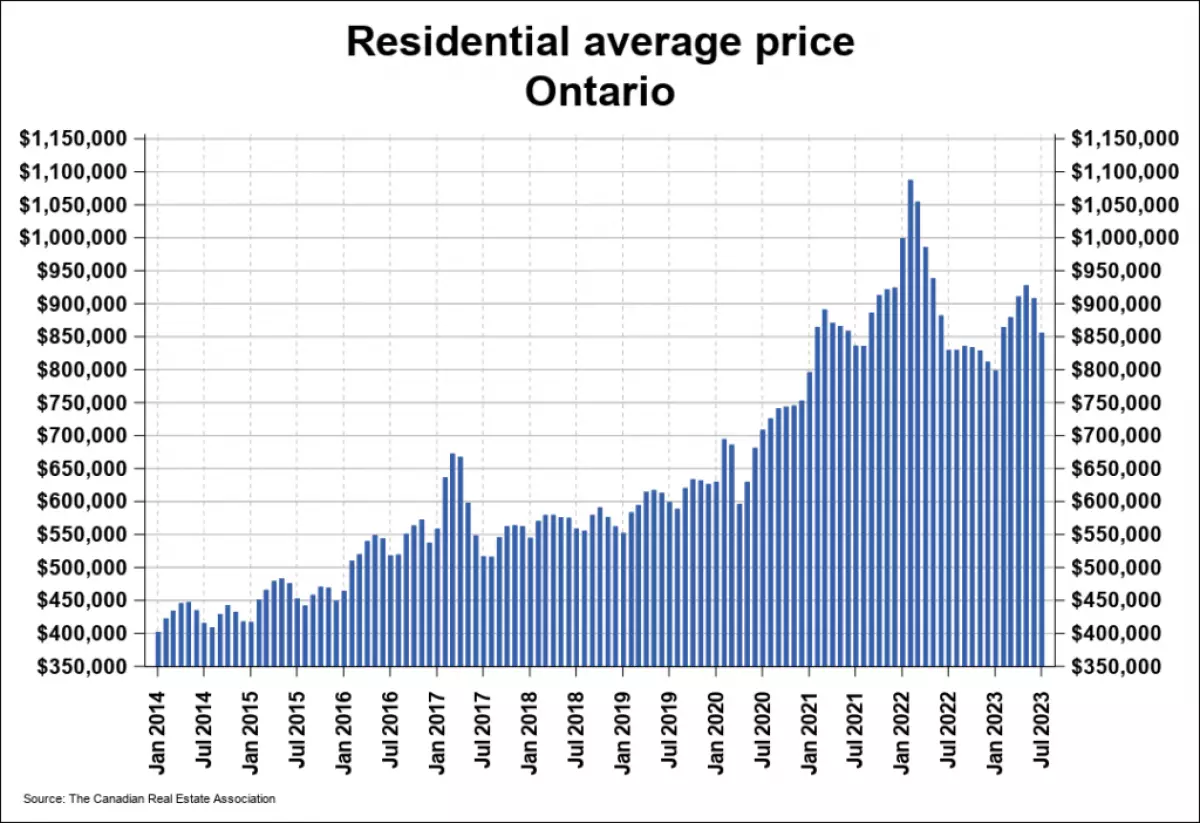Home to Canada’s capital, as well as its largest metropolitan area, Ontario is Canada’s most well-known and populated province. Nearly 40% of all Canadians call Ontario home, and the number of Canadians living in the province of the Great Lakes increases every year.
Let’s take a look at how the real estate market in Ontario is doing going into 2023.
Ontario Real Estate Market Stats
As of July 2023, the benchmark price of a residential home in Ontario was $888,891 according to the Ontario Real Estate Association. This figure represents a -9.20% change from 2022, largely due to decreased mortgage demand following the Bank of Canada’s aggressive rate hikes.
As inflation continues to slow and the Bank of Canada stops raising interest rates, we can expect to see the average price of a home in Ontario continue to rise as new housing supply lags behind population growth.
 Image Source: Ontario Real Estate Association
Image Source: Ontario Real Estate Association
How Does the Mortgage Market Affect Housing Prices in Ontario?
With the Bank of Canada increasing rates rapidly over the past year, we’ve seen firsthand the impact that the mortgage market can have on the price of homes. When interest rates rise, mortgages become more expensive, leading to fewer buyers being able to qualify for a mortgage and decreased demand for borrowing. This decrease in demand for homes has a negative impact on the price of homes. This played out in real time recently as the benchmark price of homes decreased sharply as interest rates went up.
 Image Source: Ontario Real Estate Association
Image Source: Ontario Real Estate Association
Why Are Homes in Ontario So Expensive?
Like any market, the housing market in Canada is primarily a function of supply and demand. When the demand for homes increases relative to the supply, the price will increase. Ontario is the most populated province in Canada, and most newcomers to Canada settle in the province, meaning it’s also the fastest-growing.
There’s no surprise that Toronto and the Greater Toronto Area (GTA) are one of the most popular places to live in Canada, with a diverse community and a thriving economy. Most newcomers to Canada come to Ontario, and as of the 2016 census, 75% of Ontario’s newcomers settled in the GTA. With immigration being the largest driver of population in Canada, this means the Greater Toronto Area faces the brunt of increased demand for homes. Ontario welcomed 184,725 new permanent residents in 2022, and the province’s population is expected to increase by another 1.5 million in the next 3 years.
According to a report by Scotiabank, Ontario has the largest housing deficit in Canada, with less housing per capita than any other province in the country. In order to make up the deficit, the report says, Ontario would need to build a surplus of 650,000 homes just to bring it to the same level as the rest of Canada. However, in 2022, new housing starts in Ontario were just 96,080, well below the target needed to alleviate the province's high housing prices according to analysts. What’s worse is that new starts have been trending downward in recent months, partly due to a lack of trade workers and contract issues.
Where Is the Cheapest Place to Live in Ontario?
While the Greater Toronto Area is one of the most expensive markets in Canada, that doesn’t mean that everywhere in Ontario requires a $200,000 annual salary to live in.
According to a report put out by the Ontario Real Estate Association in 2021, Thunder Bay, Sudbury, and Windsor ranked as the most affordable cities in Ontario to live in.
 Image Source: OREA, 2021
Image Source: OREA, 2021
There are also countless rural and cottage-country towns and communities with even cheaper benchmark prices. As a general rule, the further away from major city centers like Toronto and Ottawa you go, the cheaper prices will get. In a town like Longlac, Ontario, you can find a 3-bedroom bungalow for under $100,000.
Of course, these cheaper areas are cheaper for a reason. The demand for housing in remote areas of Ontario is lower because of factors like infrastructure and access to jobs. If you’re looking to relocate to a lower cost of living area without sacrificing access to amenities and a thriving job market, then you may want to consider moving to a city in another province such as Halifax or Edmonton.
Ontario Local Real Estate Market Outlooks:
Check out what our realtor partners are saying about the housing market in these Ontarian cities:
- North York, ON real estate market outlook 2023
- Brampton, ON real estate market outlook 2023
- Centre Wellington, ON real estate market outlook 2023
- Burlington, ON real estate market outlook 2023
- Oakville, ON real estate market outlook 2023
- Hamilton, ON real estate market outlook 2023
- Windsor, ON real estate market outlook 2023

















